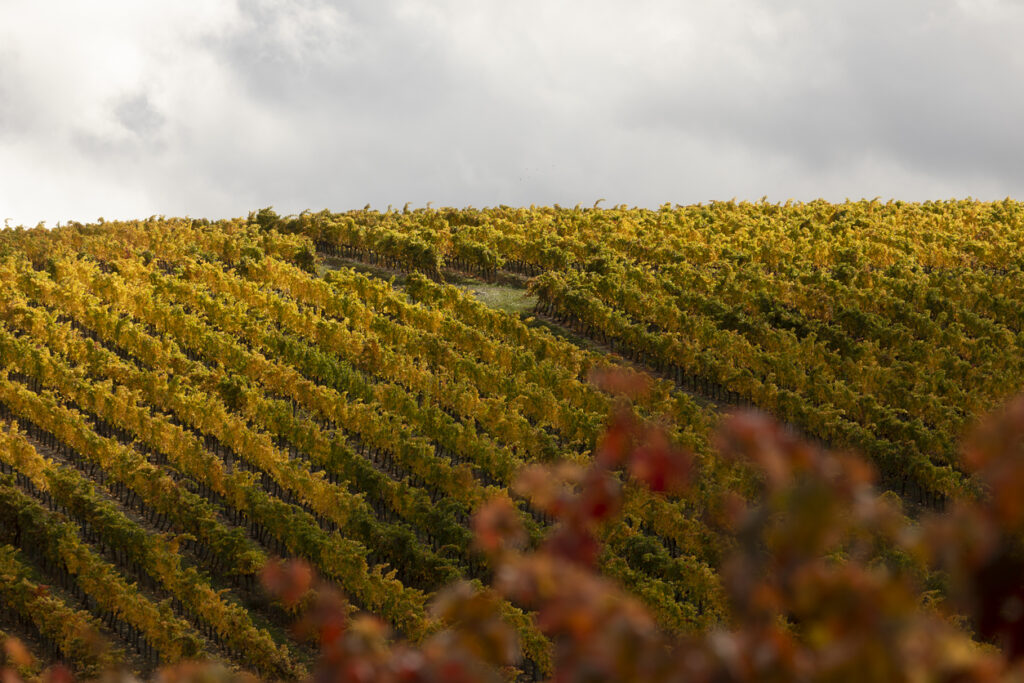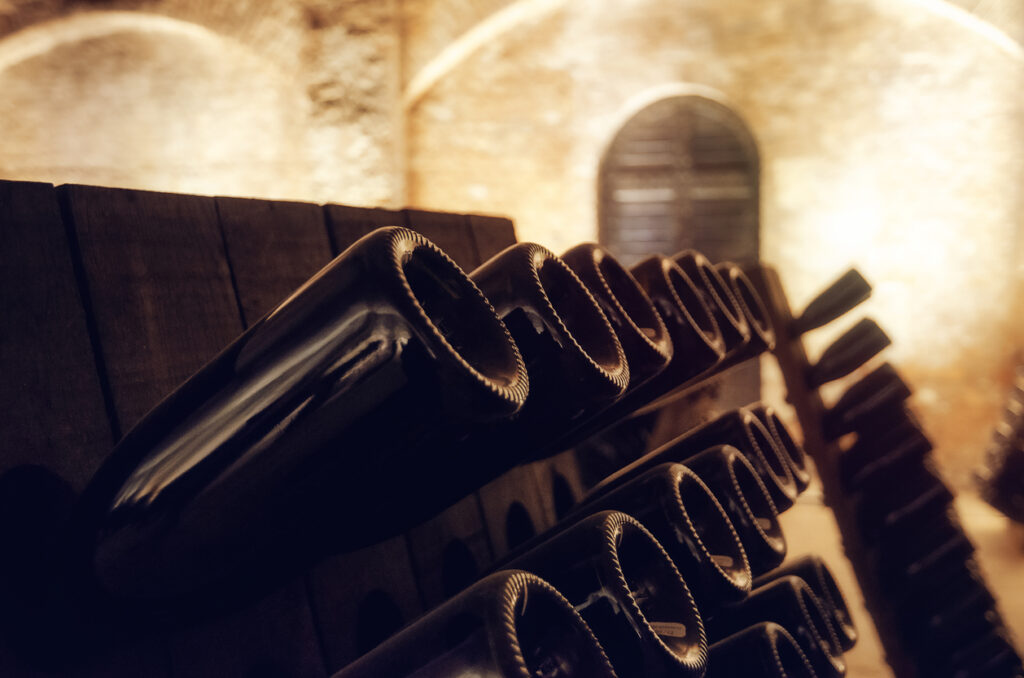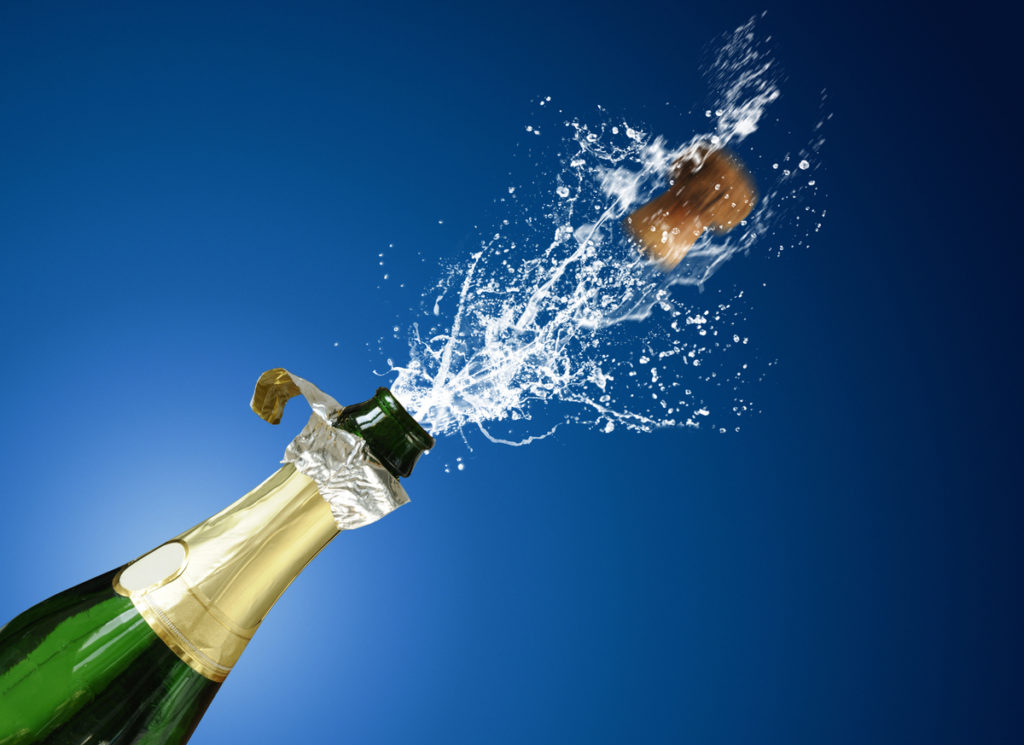Rioja, a region in Spain known for its red wines, is now making a name for itself in the world of sparkling wines. Rioja sparkling wines are made using the traditional method, which involves a secondary fermentation in the bottle, resulting in a fine and persistent bubble. The region’s unique terroir, with its combination of Atlantic and Mediterranean climates, gives Rioja sparkling wines a distinct character and complexity.
Rioja sparkling wines are made using the same grape varieties as their red counterparts, including Tempranillo, Garnacha, and Graciano. However, the grapes are harvested earlier to maintain higher acidity levels, which is crucial for producing quality sparkling wines. The resulting wines are crisp, refreshing, and elegant, with notes of citrus, green apple, and brioche.
Despite being relatively new to the sparkling wine scene, Rioja has already received recognition for its quality. In 2020, Rioja’s first sparkling wine, made by Bodegas Muga, was awarded a gold medal in the prestigious Decanter World Wine Awards. With more wineries in the region starting to produce sparkling wines, it’s clear that Rioja is a region to watch for those looking for something new and exciting in the world of bubbly.

History of Rioja Sparkling Wine
Rioja sparkling wine has a long history that dates back to the early 19th century. In 1852, the French winemaker Louis Roederer visited the region and introduced the traditional method of making sparkling wine. This method involves a secondary fermentation in the bottle, which creates the bubbles that are characteristic of sparkling wine.
The tradition of making sparkling wine in Rioja was further developed by La Rioja Alta, a winery located in Haro, Rioja. In the early 20th century, the winery began producing sparkling wine under the brand name “Viña Ardanza.” The wine was made using the traditional method and was aged for a minimum of three years in the bottle before release.

In 1972, the Rioja Consejo Regulador, the regulatory body for Rioja wine, officially recognized sparkling wine as a category within the Rioja appellation. This recognition helped to further establish Rioja sparkling wine as a high-quality product with a distinct identity.
Today, Rioja sparkling wine is made using both traditional and modern methods. The traditional method is still favored by many producers, who believe it produces the highest quality wine. However, some producers are experimenting with other methods, such as the Charmat method, which involves a secondary fermentation in a tank rather than in the bottle.
Rioja sparkling wine is often compared to Champagne, but it has its own unique character. The region’s climate and soil give the wine a distinctive flavor profile, with notes of citrus, apple, and almond. It is also known for its fine bubbles and long aging potential.
Overall, Rioja sparkling wine is a testament to the rich winemaking tradition of the region. It is a product of centuries of innovation and expertise, and it continues to evolve and improve with each passing year.

Geography and Climate
The Rioja region is situated in northern Spain, covering an area of approximately 65,000 hectares. It is located in the Ebro Valley, which is surrounded by the Cantabrian Mountains to the north and the Iberian System to the south. The region is divided into three sub-zones: Rioja Alta, Rioja Alavesa, and Rioja Oriental (formerly known as Rioja Baja).
The climate in the Rioja region is semi-continental, with hot summers and cold winters. The region experiences a significant diurnal temperature variation, which is essential for the development of grapes. The Ebro River, which flows through the region, provides water for irrigation and helps regulate the temperature.

Rioja Alta and Rioja Alavesa are located at higher altitudes, ranging from 400 to 700 meters above sea level. These sub-zones have a cooler climate than Rioja Oriental, which is located at lower altitudes. Rioja Oriental has a Mediterranean climate, with hot summers and mild winters.
The region’s soil is diverse, with a mixture of clay, limestone, and sandstone. The soil in Rioja Alta and Rioja Alavesa is rich in iron, which gives the wines a distinct flavor. Rioja Oriental has a more alluvial soil, which is ideal for growing Garnacha grapes.
The Rioja region is surrounded by other wine-producing regions, such as Navarra and Logroño. The region is home to numerous municipalities, including Haro, which is known as the wine capital of Rioja.
Overall, the geography and climate of the Rioja region provide ideal conditions for growing grapes and producing high-quality sparkling wines.

Grape Varieties
Rioja sparkling wine is produced from a variety of grapes, including red, white, and rosé. The primary grape varieties used in the production of Rioja sparkling wine are Viura, Tempranillo, Garnacha, Graciano, and Mazuelo. These grape varieties are known for their unique flavor profiles and are carefully selected to create a well-balanced and complex wine.
Viura
is the most widely planted white grape variety in Rioja and is known for its fresh and fruity notes. It is often used to add acidity and freshness to sparkling wines. Tempranillo, on the other hand, is the most widely planted red grape variety in Rioja and is known for its rich and complex flavors. It is often used to add structure and depth to sparkling wines.

Garnacha
is another red grape variety that is commonly used in the production of Rioja sparkling wine. It is known for its fruity and spicy notes and is often used to add complexity and balance to the wine. Graciano is a lesser-known grape variety that is used in small quantities in the production of Rioja sparkling wine. It is known for its high acidity and intense flavors and is often used to add structure and balance to the wine.
Mazuelo,
Also known as Carignan, is another red grape variety that is commonly used in the production of Rioja sparkling wine. It is known for its high tannins and intense flavors and is often used to add depth and complexity to the wine. Finally, Malvasia and Garnacha Blanca are white grape varieties that are sometimes used in the production of Rioja sparkling wine. They are known for their floral and fruity notes and are often used to add aroma and complexity to the wine.
Overall, the use of these grape varieties in the production of Rioja sparkling wine results in a complex and well-balanced wine that is enjoyed by wine enthusiasts around the world.
Winemaking Process
Rioja sparkling wine is made using the traditional method, also known as the Champagne method. This method involves a secondary fermentation in the bottle, which creates the bubbles that make sparkling wine so special.
The winemaking process starts with the harvest of the grapes. The grapes are carefully selected and handpicked to ensure only the best quality grapes are used. The grapes are then pressed and the juice is fermented in stainless steel tanks to produce a still wine.

Fermentation
Once the still wine is produced, it is blended and bottled with a mixture of yeast and sugar, known as the tirage. The tirage is what starts the secondary fermentation in the bottle. The bottles are then sealed with a crown cap and left to age on their side for a minimum of 9 months.
During this aging process, the yeast consumes the sugar and produces carbon dioxide, which dissolves into the wine and creates the bubbles. The longer the wine ages on the lees, the more complex and nuanced the flavors become.
Ageing
After the aging process is complete, the bottles are riddled, which involves turning them upside down and shaking them to move the lees towards the neck of the bottle. The neck of the bottle is then frozen and the crown cap is removed, allowing the pressure to expel the lees from the bottle.
The wine is then topped up with a mixture of wine and sugar, known as the dosage, to balance the acidity and sweetness of the wine. The final step is to cork the bottle with a cork and wire cage, ready for consumption.

Rioja sparkling wine is often aged in oak barrels, which can add additional flavors of wood, leather, and baking spice to the wine. French oak and American oak are the most commonly used barrels, each imparting their own unique flavors to the wine.
Overall, the winemaking process for Rioja sparkling wine is a careful and time-consuming process that requires a great deal of skill and expertise. The result is a delicious and complex wine that is perfect for any occasion.
Types and Styles of Rioja Sparkling Wines
Rioja sparkling wines are a unique and exciting offering from the Rioja wine region in Spain. These wines are made using the traditional method, also known as the Champagne method, where the secondary fermentation takes place in the bottle. This process results in a complex and flavorful wine that is perfect for any occasion.
There are several types and styles of Rioja sparkling wines to choose from, each with its own unique characteristics. The following are some of the most popular types and styles of Rioja sparkling wines:
Viñedo Singular
This is a single-vineyard wine that is made from a specific plot of land. These wines are highly sought after and are known for their exceptional quality and complexity.
Crianza
This type of Rioja sparkling wine is aged for a minimum of 15 months, with at least 9 months spent in the bottle. These wines are known for their fruity and floral aromas, with a smooth and elegant finish.

Reserva
Reserva Rioja sparkling wines are aged for a minimum of 24 months, with at least 18 months spent in the bottle. These wines have a more intense flavor profile, with notes of toasted bread, nuts, and dried fruit.
Gran Reserva
This is the highest quality Rioja sparkling wine, aged for a minimum of 36 months, with at least 30 months spent in the bottle. These wines are complex and sophisticated, with a rich and full-bodied flavor that is perfect for special occasions.
Rioja sparkling wines are available in a variety of styles, including red wine, white wines, and rosé wines. The white wine and rosé wine styles are particularly popular, as they offer a refreshing and light alternative to traditional still Rioja blanco.
Overall, Rioja sparkling wines are a unique and exciting offering from the Rioja wine region, with something to suit every taste and occasion. Whether you prefer a single-vineyard wine or a more complex and sophisticated Gran Reserva, Rioja sparkling wines are sure to impress.

Classification and Certification
Rioja sparkling wines are classified and certified by the Consejo Regulador, the regulatory council that oversees the production and quality of wines from the Rioja region. The council has established a classification system that categorizes Rioja sparkling wines based on their aging and production methods.
The classification system includes four categories: Joven, Crianza, Reserva, and Gran Reserva. Joven wines are the youngest and are typically released within a year of production. Crianza wines are aged for at least two years, with a minimum of six months in oak barrels. Reserva wines are aged for at least three years, with a minimum of one year in oak barrels. Gran Reserva wines are aged for at least five years, with a minimum of two years in oak barrels.

In addition to the aging classification, Rioja sparkling wines can also be classified based on the vineyards where the grapes are grown. Wines made from grapes grown in a single vineyard are known as Viñedos Singulares. These wines are considered to be of the highest quality and are subject to strict certification requirements.
Certification of the Sparkling Wines
To receive certification as a Rioja sparkling wine, the wine must meet certain quality standards established by the Consejo Regulador. The wine must be made from grapes grown in the Rioja region and must be produced using traditional methods. The wine must also pass a blind tasting test conducted by the council to ensure its quality.
Rioja sparkling wines that meet the certification requirements are granted the Denominación de Origen Calificada (DOCa) status, which is the highest quality indication in Spain. The DOCa status is only granted to wines that have a proven track record of consistent quality and are produced in a specific geographic region.

Overall, the range of Rioja sparkling wines offers a variety of options for wine enthusiasts. From the young and fresh Joven wines to the complex and aged Gran Reserva wines, there is something for everyone. The classification and certification system established by the Consejo Regulador ensures that consumers can trust the quality and authenticity of Rioja sparkling wines.
Prominent Wineries
Rioja Sparkling Wine is produced by several prominent wineries in the Rioja region of Spain. These wineries have a long history of producing high-quality wines, and their sparkling wines are no exception. Here are a few of the most prominent wineries:
Bodegas Muga
Bodegas Muga is one of the most respected wineries in Rioja. They have been producing wine since 1932 and are known for their traditional winemaking techniques. They produce a range of wines, including a sparkling wine called Muga Conde de Haro Brut. This wine is made using the traditional method, and it has a delicate, fruity flavor with a hint of toast.

La Rioja Alta
La Rioja Alta is another well-respected winery in Rioja. They have been producing wine for over 125 years and are known for their commitment to quality. They produce a range of wines, including a sparkling wine called Viña Alberdi Brut. This wine is made using the traditional method and has a crisp, refreshing taste with notes of citrus and apple.

Campo Viejo
Campo Viejo is one of the largest wineries in Rioja,. They produce a wide range of wines, including a sparkling wine called Campo Viejo Cava Brut Reserva. This wine is made using the traditional method. It has a bright, fresh taste with notes of green apple and citrus.
CVNE
CVNE (Compañía Vinícola del Norte de España) is one of the oldest wineries in Rioja, with a history dating back to 1879. They produce a range of wines, including a sparkling wine called CVNE Cava Brut Reserva. This wine is made using the traditional method, and it has a complex, elegant flavor with notes of brioche and honey.

Labastida
Labastida is a small, family-owned winery in Rioja that produces a range of wines, including a sparkling wine called Labastida Cava Brut. This wine is made using the traditional method, and it has a crisp, refreshing taste with notes of green apple and pear.
Overall, these wineries are some of the most prominent producers of Rioja Sparkling Wine, and their wines are well worth trying for anyone who enjoys sparkling wine.

Pairing Rioja Sparkling Wine with Food
Rioja Sparkling Wine is a versatile drink that pairs well with a wide range of foods. Whether you’re enjoying a glass with friends or pairing it with a meal, there are plenty of options to choose from.
When it comes to pairing Rioja Sparkling Wine with food, there are a few things to keep in mind. First, consider the flavor profile of the wine. Rioja Sparkling Wine is known for its crisp, refreshing taste, with notes of citrus, apple, and pear. This makes it a great match for light, fresh dishes that won’t overpower the wine.
One classic pairing for Rioja Sparkling Wine is tapas. These small, flavorful dishes are perfect for sharing with friends and pairing with a glass of bubbly. Some popular tapas options to try include:

- Patatas bravas: crispy potatoes served with a spicy tomato sauce
- Croquetas: creamy, fried balls of ham, cheese, or seafood
- Gambas al ajillo: sautéed shrimp with garlic and chili flakes
- Tortilla española: a hearty potato and onion omelet
In addition to tapas, Rioja Sparkling Wine also pairs well with seafood, salads, and light pasta dishes. Some specific options to consider include:
- Grilled shrimp or scallops with a citrus vinaigrette
- Arugula salad with goat cheese and sliced apples
- Linguine with lemon and olive oil
Overall, when it comes to pairing Rioja Sparkling Wine with food, the key is to keep it light and fresh. With its crisp, refreshing taste, this wine is the perfect complement to a wide range of dishes.

Innovation and Future Trends
Rioja sparkling wine has been gaining popularity in recent years, and with that comes innovation and future trends. The wine world is always evolving, and Rioja sparkling wine is no exception.
One area of innovation is the diversity of Rioja sparkling wines. While traditionally made with the Viura grape, winemakers are experimenting with other grape varieties such as Tempranillo and Garnacha. This experimentation allows for a wider range of flavors and styles, appealing to a broader audience.

Traditional Method
Another area of innovation is the use of the traditional method for sparkling wine production. This method involves a secondary fermentation in the bottle, resulting in a finer, more complex wine. Rioja quality sparkling wines produced using this method are gaining recognition and are becoming increasingly popular.

